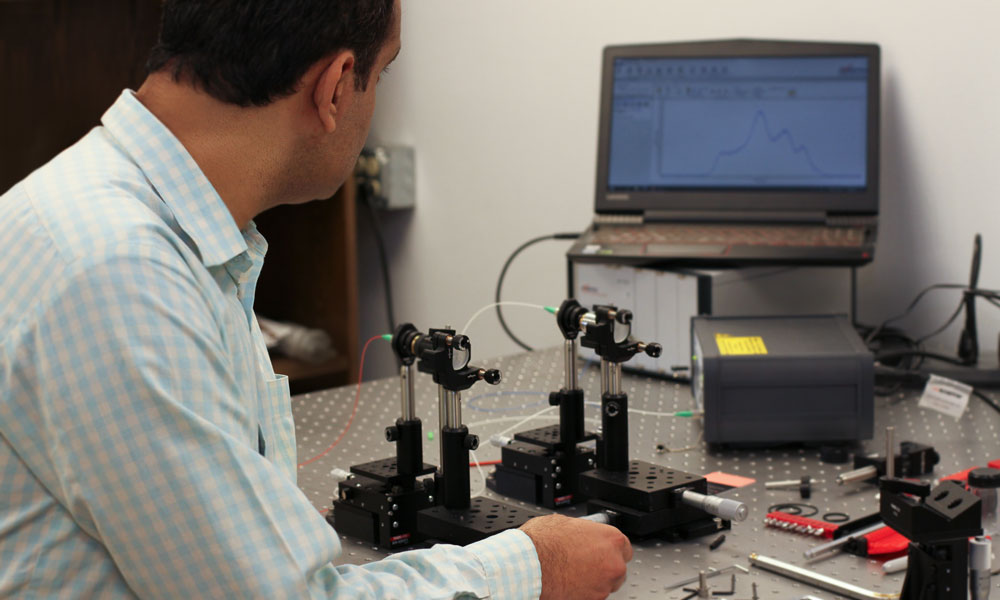
Facilities at Haggerty Hall | Facilities at MCW
The Marquette University and Medical College of Wisconsin (MCW) Department of Biomedical Engineering provides two laboratories for biophotonics: a 900-sq-ft laboratory in Haggerty Hall at Marquette University for optical instrumentation and an 800-sq-ft laboratory in MCW for animal studies and ex vivo tissue experimentation. Both labs are appropriately equipped to support a variety of biophotonics research and educational activities.
Biophotonics Facilities at Haggerty Hall
The Biophotonics Facilities in Haggerty Hall at Marquette University are uniquely equipped to support research involving optical instrumentation, fiber-optic probe and sensor fabrication, tissue phantom preparation and testing, and advanced data analysis.
Expand all | Collapse all
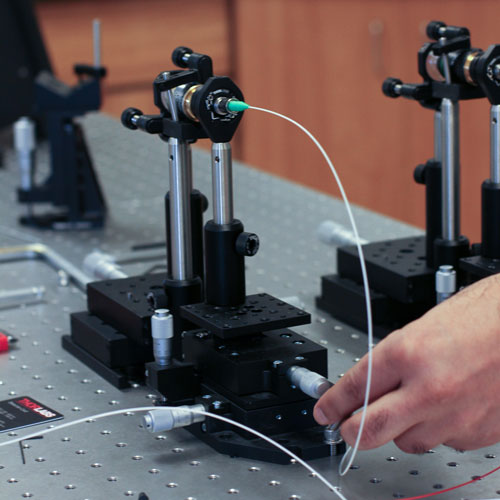 The Biophotonics Lab at Haggerty Hall has the resources necessary for performing optical instrumentation. The Zemax OpticStudio@ software facilitates professional design and simulation of optical imaging, spectroscopy and sensing systems. Our darkroom is equipped with a 4-by-6-foot optical table and various optical stages and scanners, allowing researchers and students to build and test new ideas for tissue optical imaging and spectroscopy. Quick prototype testing can be accomplished using our 3D printer, NI ELVIS III workstation, three laptop computers, oscilloscope, function generators, power supplies, optical power meter, various light sources, optical filters, objectives and lens, and LabVIEW software.
The Biophotonics Lab at Haggerty Hall has the resources necessary for performing optical instrumentation. The Zemax OpticStudio@ software facilitates professional design and simulation of optical imaging, spectroscopy and sensing systems. Our darkroom is equipped with a 4-by-6-foot optical table and various optical stages and scanners, allowing researchers and students to build and test new ideas for tissue optical imaging and spectroscopy. Quick prototype testing can be accomplished using our 3D printer, NI ELVIS III workstation, three laptop computers, oscilloscope, function generators, power supplies, optical power meter, various light sources, optical filters, objectives and lens, and LabVIEW software.
Fiber-optic Probe and Sensor Fabrication
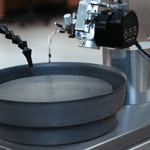 The Biophotonics Lab at Haggerty Hall features an ULTRAPOL End & Edge polisher, Fujikura FSM-100M Specialty Fiber Fusion Splicers, a high-precision drill, two inspection microscopes, an optical fiber cleaver, a fiberscope, a 3D printer, and plenty of bench space, making it uniquely equipped for fiber-optic probe and sensor fabrication.
The Biophotonics Lab at Haggerty Hall features an ULTRAPOL End & Edge polisher, Fujikura FSM-100M Specialty Fiber Fusion Splicers, a high-precision drill, two inspection microscopes, an optical fiber cleaver, a fiberscope, a 3D printer, and plenty of bench space, making it uniquely equipped for fiber-optic probe and sensor fabrication.
Tissue Phantom Preparation and Testing
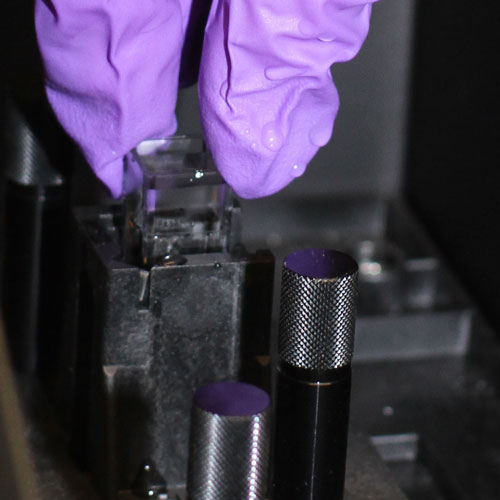 The Biophotonics Facilities at Haggerty Hall includes a wet lab designed for testing and calibration of new optical instrumentation and sensors using tissue-mimicking phantoms. The wet lab features a LAMBDA35 spectrophotometer and heated water bath with dedicated refrigerator, chemical hood, and glassware.
The Biophotonics Facilities at Haggerty Hall includes a wet lab designed for testing and calibration of new optical instrumentation and sensors using tissue-mimicking phantoms. The wet lab features a LAMBDA35 spectrophotometer and heated water bath with dedicated refrigerator, chemical hood, and glassware.
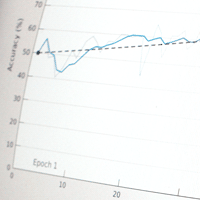 For data analysis, the MU Lab has an EXXACT custom workstation driven by a Titan RTX graphics card for deep or machine learning projects, as well as an HP EliteDesk 705 G4 Workstation for image processing and executing Monte Carlo forward or inverse models related to diffuse reflectance spectroscopy of UV-visible light and NIR radiation. The facility features a variety of scientific and engineering software packages, including MATLAB with all toolboxes, ImageJ, and SolidWorks. In addition, this facility provides four regular desktop computers dedicated to routine work.
For data analysis, the MU Lab has an EXXACT custom workstation driven by a Titan RTX graphics card for deep or machine learning projects, as well as an HP EliteDesk 705 G4 Workstation for image processing and executing Monte Carlo forward or inverse models related to diffuse reflectance spectroscopy of UV-visible light and NIR radiation. The facility features a variety of scientific and engineering software packages, including MATLAB with all toolboxes, ImageJ, and SolidWorks. In addition, this facility provides four regular desktop computers dedicated to routine work.
Biophotonics Facilities at MCW
Located directly above MCW’s distinct animal facilities, the Biophotonics Facilities at MCW focus on animal studies and ex vivo tissue experimentation. The facilities host four ongoing projects: (1) rapid and high-resolution imaging of breast tumor margins using deep UV fluorescence scanning microscopy; (2) measuring tumor hypoxia and its response to drugs using frequency-domain near-infrared spectroscopy (NIRS); (3) measuring liver hemoglobin contents and saturation during artery occlusion using visible diffuse reflectance spectroscopy (VIS-DRS) and (4) real-time monitoring of endotracheal tube displacement.
In addition, the Biophotonics Facilities at MCW provide investigators access to the Translational and Biomedical Research Center (TBRC) open-concept design space. The open-concept design allows for the most effective equipment and resource sharing, as well as scientific exchange and collaboration. The TBRC occupies 7,144 sq. ft. and includes shared equipment and facilities, to which all investigators and their laboratories have full access.
Learn More about TBRC
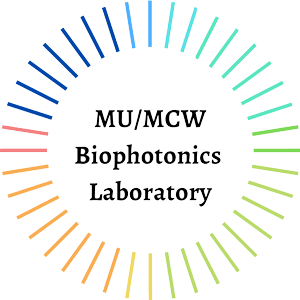 Research | Facilities | People
Research | Facilities | People

 The Biophotonics Lab at Haggerty Hall has the resources necessary for performing optical instrumentation. The Zemax OpticStudio@ software facilitates professional design and simulation of optical imaging, spectroscopy and sensing systems. Our darkroom is equipped with a 4-by-6-foot optical table and various optical stages and scanners, allowing researchers and students to build and test new ideas for tissue optical imaging and spectroscopy. Quick prototype testing can be accomplished using our 3D printer, NI ELVIS III workstation,
The Biophotonics Lab at Haggerty Hall has the resources necessary for performing optical instrumentation. The Zemax OpticStudio@ software facilitates professional design and simulation of optical imaging, spectroscopy and sensing systems. Our darkroom is equipped with a 4-by-6-foot optical table and various optical stages and scanners, allowing researchers and students to build and test new ideas for tissue optical imaging and spectroscopy. Quick prototype testing can be accomplished using our 3D printer, NI ELVIS III workstation,  The Biophotonics Lab at Haggerty Hall features an ULTRAPOL End & Edge polisher,
The Biophotonics Lab at Haggerty Hall features an ULTRAPOL End & Edge polisher,  The Biophotonics Facilities at Haggerty Hall includes a wet lab designed for testing and calibration of new optical instrumentation and sensors using tissue-mimicking phantoms. The wet lab features a LAMBDA35 spectrophotometer and heated water bath with dedicated refrigerator, chemical hood, and glassware.
The Biophotonics Facilities at Haggerty Hall includes a wet lab designed for testing and calibration of new optical instrumentation and sensors using tissue-mimicking phantoms. The wet lab features a LAMBDA35 spectrophotometer and heated water bath with dedicated refrigerator, chemical hood, and glassware. For data analysis, the MU Lab has an EXXACT custom workstation driven by a Titan RTX graphics card for deep or machine learning projects, as well as an HP EliteDesk 705 G4 Workstation for image processing and executing Monte Carlo forward or inverse models related to diffuse reflectance spectroscopy of UV-visible light and NIR radiation. The facility features a variety of scientific and engineering software packages, including MATLAB with all toolboxes, ImageJ, and SolidWorks. In addition, this facility provides four regular desktop computers dedicated to routine work.
For data analysis, the MU Lab has an EXXACT custom workstation driven by a Titan RTX graphics card for deep or machine learning projects, as well as an HP EliteDesk 705 G4 Workstation for image processing and executing Monte Carlo forward or inverse models related to diffuse reflectance spectroscopy of UV-visible light and NIR radiation. The facility features a variety of scientific and engineering software packages, including MATLAB with all toolboxes, ImageJ, and SolidWorks. In addition, this facility provides four regular desktop computers dedicated to routine work.